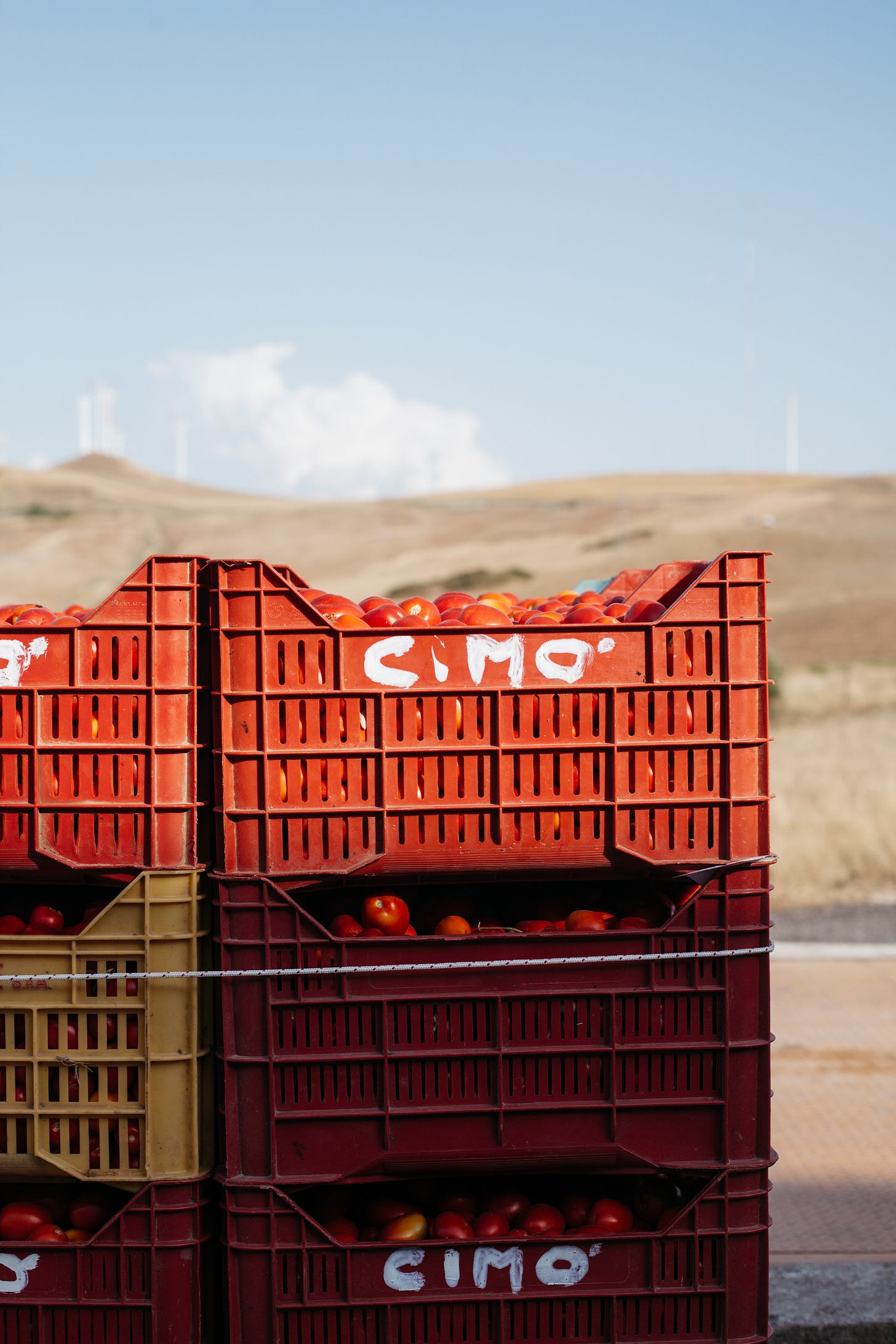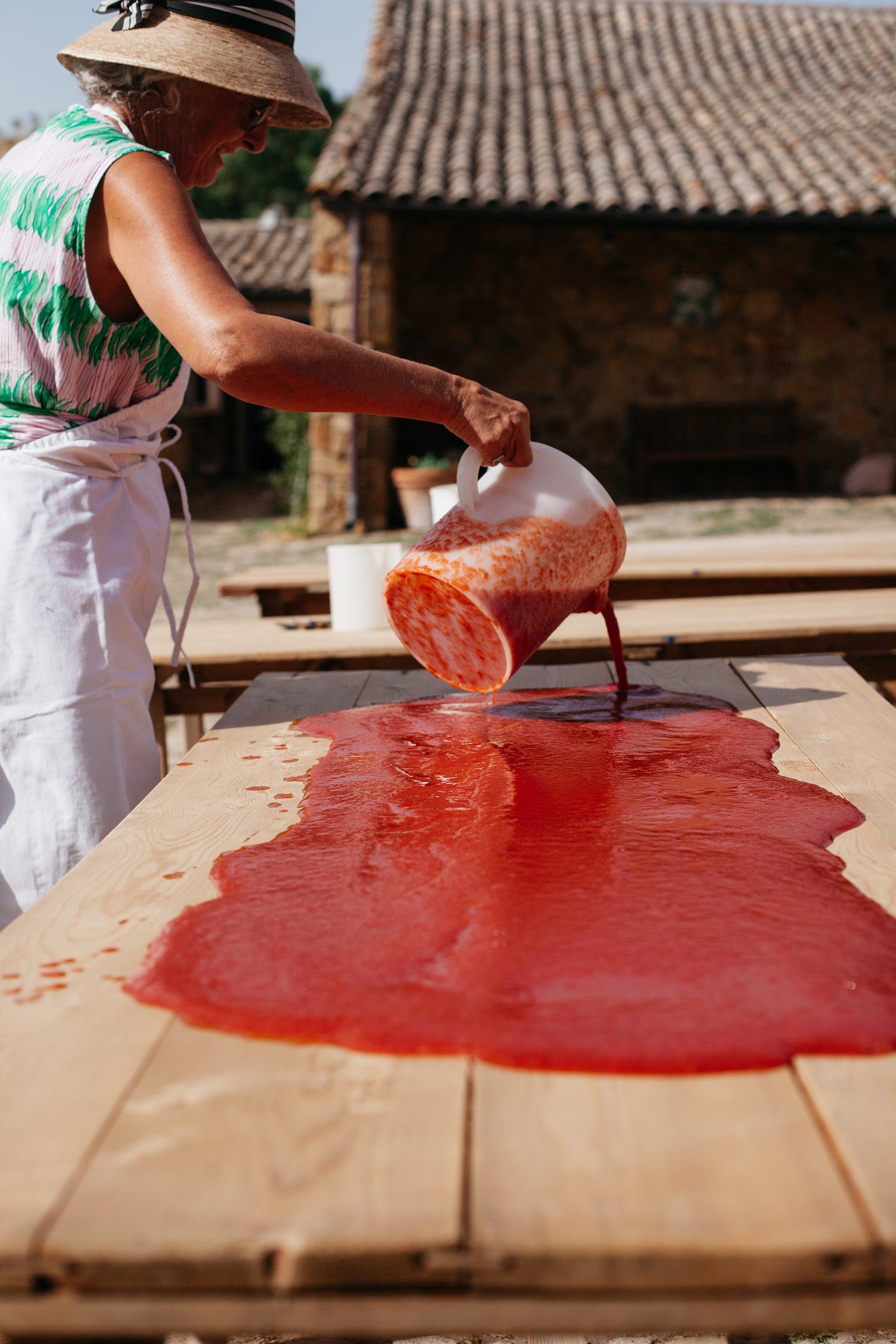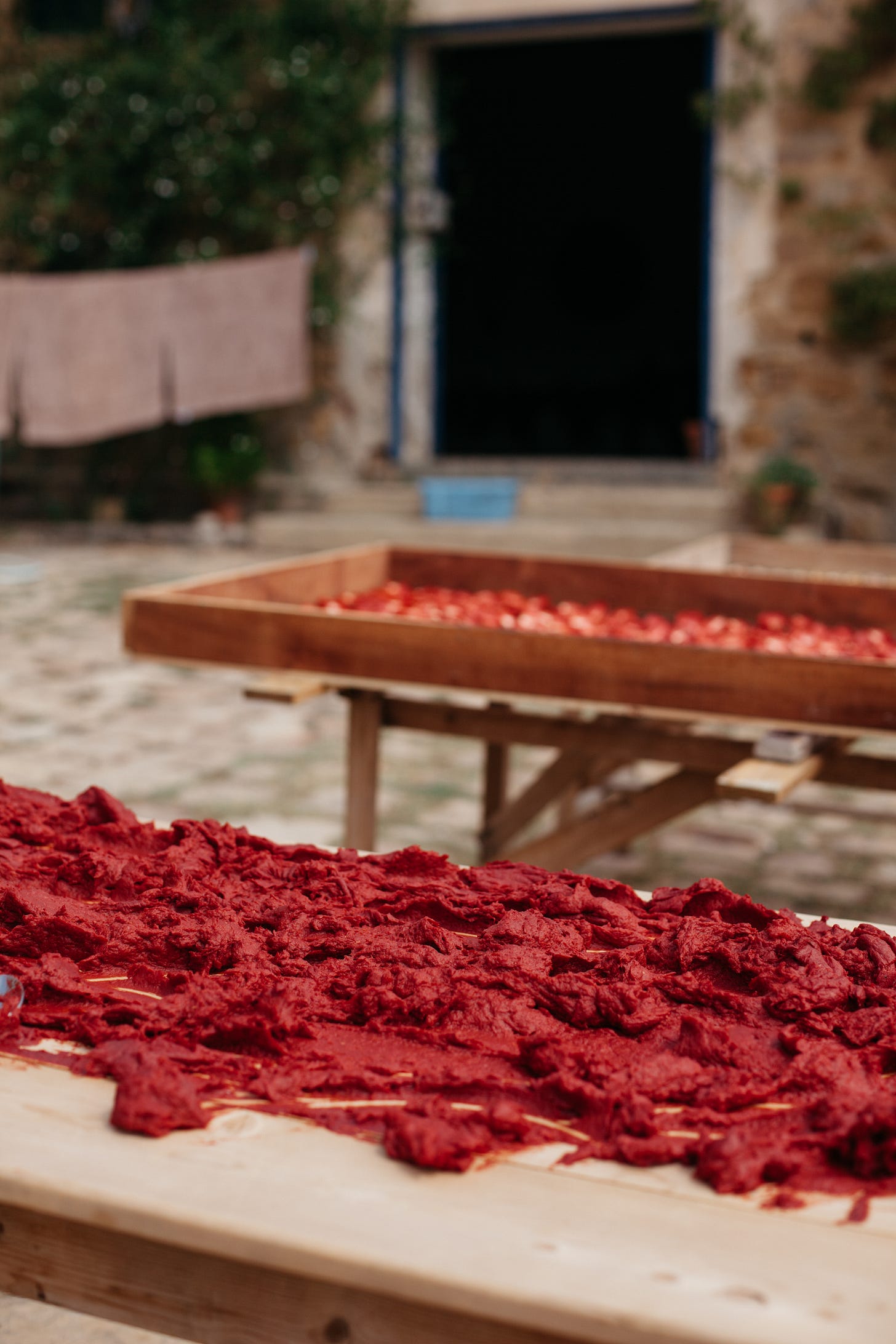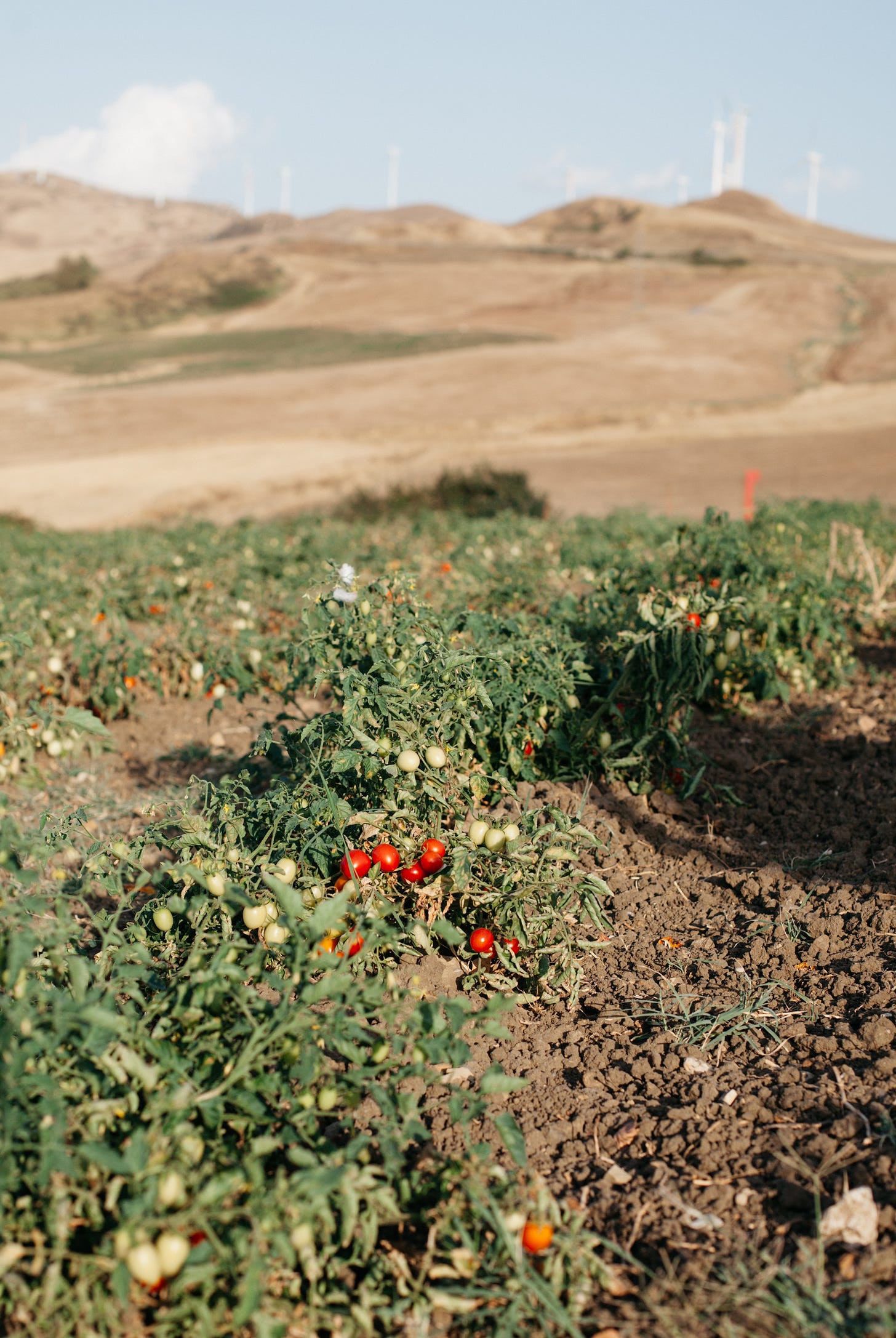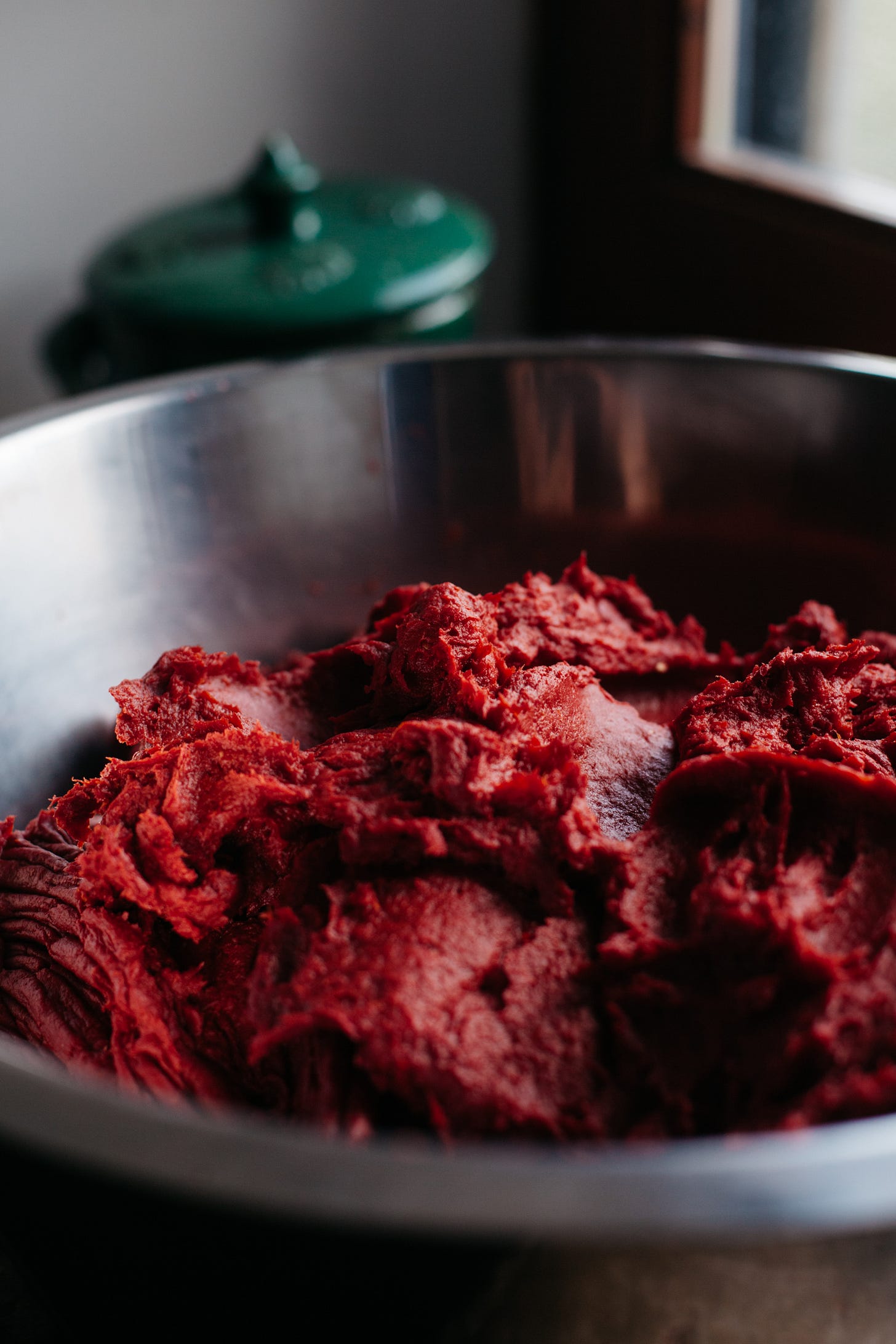Making tomato paste in Sicily
And the most asked question!
It started with 120 kilos of tomatoes — not sweet San Marzano but the dense, savoury siccagno tomatoes, which are grown without any water in hot, dry, mountainous central Sicily. We picked out the prettiest, largest ones for sun drying on a large rack in the cobblestoned courtyard of Case Vecchie and the rest were chopped for the next two hours, placed in enormous pots and cooked down with onion, garlic and fresh bay leaves. The pulp, once milled to remove the skins and seeds, and seasoned very, very generously with salt, was spread over wooden tables in the courtyard — the same ones that Fabrizia Lanza has been using for the past twenty years for her cooking classes at Anna Tasca Lanza.
The hot Sicilian sun — long an important resource here — and warm wind did most of the work from this point. We kept an eye on it, occasionally stirring and moving the tomato juice around the table until the water dripped out of it and it became a luscious, thick paste. Each night, we would bring the tables inside to avoid any moisture from the night air, and every morning we would bring them back out into the hot sun of the day to undergo another transformation (in the photos below you see the difference between day 1 and day 3).
I posted many photos and videos of the whole process in stories on Instagram and got a flood of curious and concerned messages, all asking the same thing:
But what about the flies?
The short answer is they just weren’t even a problem. I filmed a short video of the tables to show how there weren’t any flies hanging around. In fact, the wide, pristine courtyard of Case Vecchie is a perfectly protected space, with the kitchen, the barn, the rooms surrounding it in a perfect square. The sun beats down, making it the perfect place for sun drying — laundry, figs, tomato paste — and there, surrounded by the school’s gardens and vineyards, in the middle of nothing but golden rolling hills and wheat fields, cars rarely pass by. So it is an incredibly uncontaminated place for an activity like this.
I’m no fly expert (although as an Australian, I understand the concern! Flies are a serious problem in Australia), but I offer some peace of mind here for those who wondered about it. Flies really love decaying organic matter, moisture and trash so maybe this freshly made, delightful, rich tomato paste is just not something they’re interested in. Bay leaf is a natural fly repellent, as are basil and mint, which sit in the courtyard too in large pots with many other herbs. It’s also incredibly dry and windy among the central Sicilian mountains (flies don’t do well in the wind).
All of these things made me realise there is perhaps a good reason why astrattu, or tomato paste, has been made this way for centuries in this part of Sicily. You do not necessarily find it done this way anywhere else in Italy, and transferring this tradition to other parts of the world may not work so beautifully either. In other words, Anna Tasca Lanza’s Case Vecchie has simply the perfect conditions for making tomato paste for several days in late August on wooden tables, as they have done for generations.
I personally cannot think of anything more beautiful than this tomato extract made this way, slowly and naturally, ecologically with the sun and wind and time doing their part. It is incomparable to something you would buy at a supermarket — could you imagine eating it with a spoon as I did with the one we made? I couldn’t!
This discussion about flies reminded me of an investigative Italian TV show, Le Iene (‘the hyenas’), that revealed in 2015 that huge Italian tomato companies were importing hundreds of thousands of tons of Chinese tomato paste to add to their “Made in Italy” tomato sauces and products — and to make this horrifying idea even worse, it was revealed that the Italian companies, in order to pay even less for their tomato paste, preferred buying the cheapest quality available which contained a guaranteed portion of flies and maggots. Watch the episode here in Italian (or here for a Youtube version where you can add subtitles - use the settings button under the video to switch to automated English subtitles).
Is what we buy commercially better and ‘cleaner’ than homemade and artisan? And doesn’t it make you think about what is the actual cost of buying things cheaper?
These beautiful, organic, drought-resistant, heirloom, Slow Food Sicilian tomatoes that we used cost only 50 cents a kilo. We visited a wonderful cooperative of siccagno tomatoes, Rinascita, not far from Case Vecchie and of the 20 producers that are part of the cooperative, only 3 are not over 60 years old, I couldn’t help but think of them bending over the tiny low bushes in the hot August sun (temperatures broke records this summer - 46C/115F in this area) — these are picked manually.
On the subject of costs, then there are the numerous devastating reports over the past years (there are plenty in Italian in all the major news outlets, in English see this excellent, if dark, long-read Guardian article here by Tobias Jones and Ayo Awokoya — and be prepared to dive deep into a subject that will make you feel sad and angry) that slavery is alive and well in Italian tomato fields, labour being the place where costs can be squeezed to sell tomato products at the low prices supermarkets insist on selling at (the going rate for tomatoes in the industry for processing tomato products for supermarket shelves is actually around 7.5 cents per kilo).
I have long avoided any big brand Italian tomato brands (yes, sadly, even those favourites that you are thinking of have been involved, either knowingly or not), choosing instead always organic and very locally grown tomatoes with a shorter chain and a higher price tag — even better, grow your own, if you can, you don’t even need a vegetable patch (my mother grows tomatoes quite successfully in pots in her courtyard in Australia). Or perhaps start a group project with a couple of friends/family growing tomatoes or finding the best organic ones at your farmers market, bring them all to someone’s house and chop, cook and bottle them together!
Canning or bottling tomatoes on your own is rewarding, delicious and, like the tomato paste, I find it quite meditative to do too — admittedly not all of us have a sunny courtyard to do tomato paste in but Carla Tomasi, one of my favourite Roman cooks and gardeners, has this brilliant solution if you have little space and have flies (or cats!) that you are concerned about!
Here are some fresh tomato recipes to try:
Tuscan pomarola, which is a tomato sauce complete with carrot, celery, onion and aromatics in it - just bottle and use whenever you like right on pasta or in soups.
Simply roasted tomatoes (this intensifies flavours) with olive oil, herbs and garlic, then blitz into sauce and bottle or freeze.
Oven roasted tomatoes preserved in oil from Domenica Marchetti’s Preserving Italy.
Do you have a favourite way to preserve fresh tomatoes? Leave a comment below to inspire others! Until next week,
Emiko x


